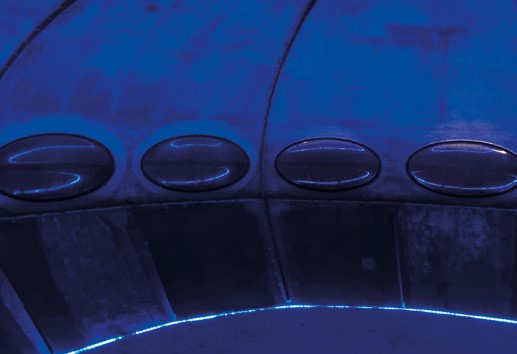A Living Space
Downloads
DOI:
https://doi.org/10.52200/docomomo.66.08Keywords:
Futuro, GFRP, Investigation, degradation, preservationAbstract
The restoration of the Futuro house in Corfu is complicated by being both an art object and a living space. The glass-fiber reinforced polymer (GFRP) materials showed damage that could be related to ageing and exposure to the local, unfavorable environmental conditions (light, humidity and temperature). In order to establish the technical condition of the building, non-destructive techniques were used. Additionally, indoor air quality was tested. The research has shown that the most relevant causes of damage to GFRP materials are moisture, exposure to sunlight and thermal changes. The intervention strategies applied so far are not conclusive. Maintenance is always needed. Further investigations are deemed necessary to understand the properties and state of conservation of the materials at a micro scale.
How to Cite
Published
Issue
Section
License
Copyright (c) 2022 Eugenia Stamatopoulou, Maria Karoglou, Asterios Bakolas

This work is licensed under a Creative Commons Attribution 4.0 International License.
Plaudit
References
ARRAS, Peter, PEETERS, Chris, IVENS, Jan, “Reliability of Ageing Composite Constructions”, in Marian Kucera, Milan Kadnar, Vlastimil Maly, Silvia Bodlalova (Eds.), Nové Trendy v Konštruovaní a v Tvorbe Technickej Dokumentácie 2008 = New Trends in Design and Technical Documentation Creation: Proceedings of Scientific Works (on cd-rom) (Eds.)(1-4). Presented at the New Trends in Design and Technical Documentation Creation, Slovak University of Agriculture (Nitra), Slovak Republic, 22 May 2008-22 May 2008.
AWAJA, Firas Awaja, ZHANG, Shengnan, TRIPATHI, Manoj, NIKIFOROV, Anton Nikiforov, PUGNO, Nicola “Cracks, Microcracks and Fracture in Polymer Structures: Formation, Detection, Autonomic Repair”, Progress in Materials Science,Vol. 83, 2016, 536–573.
BAGHERPOUR, Salar, “Fibre Reinforced Polyester Composites” in Hosam Saleh (Ed.), Polyester, Chapter 6, 2012, 136-166.
CARRA, Guglielmo, CARVELLI, Valter “Ageing of Pultruded Glass Fibre Reinforced Polymer Composites Exposed to Combined Environmental Agents”, Composite Structures, Vol. 108, February 2014, 1019–1026.
FOWLER, Timothy J., MASLOV, Konstantin, MOON, Tess, Inspecting FRP Composite Structures with Nondestructive Testing, Report Number 1892-1, Center for Transportation Research Bureau of Engineering Research, The University of Texas at Austin, 2001, 148.
HARIZI, Walid, CHAKI, Salim, BOURSE, Gerard, OURAK, Mohamed, “Mechanical Damage Assessment of Glass Fiber-Reinforced Polymer Composites Using Passive Infrared Thermography”, Composites Part B: Engineering, Vol. 59, March 2014, 74-79.
HOME, Marko, TAANILA, Mika (Eds). Futuro: Tomorrow’s House from Yesterday, Helsinki, Desura, 2002.
ENGELSMANN, Stephan, SPALDING, Valerie, PETERS, Stefan, Plastics: In Architecture and Construction, Basel, Birkhäuser, 2010.
ITAM, Zarina, ARIFIN, Zainalm, ISHAK, Mohd, YSOF, Zulkifli Mohd, SALWI, Nadiah, ZAINOODIN, Mahyun, “Effect on the Temperature Behavior of Glass Fiber Reinforced Polymer (GFRP) in Various Application - A Review” AIP Conference Proceedings, Vol. 2031, Published Online: 29 November 2018, pp. 020026/1- 020026/4, (https://doi.org/10.1063/1.5066982).
MASUELLI, Martin Alberto, “Introduction of Fibre-Reinforced Polymers-Polymers and Composites: Concepts, Properties and Processes” in Martin Alberto Masuelli (Ed.), Fiber Reinforced Polymers-The Technology Applied for Concrete Repair, Rijeka, InTech, 2013, pp.3-27.





